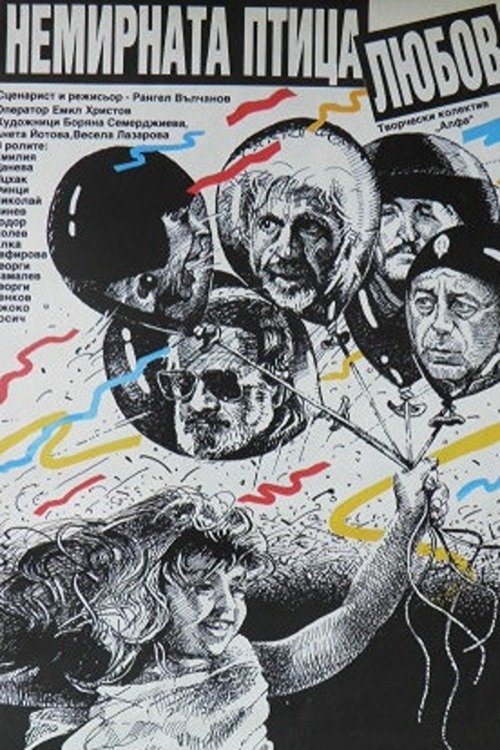
Ask Your Own Question
What is the plot?
The film opens in a timeless, almost mythical space, where a girl emerges as if from Pandora's Box, her presence both ethereal and ominous. She does not speak but her gaze pierces the veil of time, foretelling the drama humanity is about to endure--a reckoning for the sins accumulated through the ages. This prologue sets the tone: a meditation on love, sin, and the eternal conflict between the sublime and the base. The girl's emergence is like the unleashing of a curse or a revelation, a symbolic act that frames the entire narrative.
From this allegorical beginning, the story shifts into a series of parodic vignettes, each directed by a different filmmaker within the film's meta-structure. The central figure among the characters is Dzhoni Petela, played by Georgi Penkov, a man whose life and relationships embody the tangled complexities of modern existence. Dzhoni is introduced in a bustling urban environment, a cityscape that reflects the fragmented, transient nature of contemporary life. His demeanor is both charismatic and troubled, hinting at inner conflicts that will unravel as the story progresses.
Krasivata, "The Beautiful One," portrayed by Vania Tzvetkova, enters the narrative as a figure of allure and mystery. Her beauty is not merely physical but symbolic, representing the idealized yet elusive nature of love itself. She moves through the urban settings with a grace that contrasts sharply with the gritty reality around her. Her interactions with Dzhoni are charged with tension--both romantic and existential. At one point, she confronts him with a piercing question: "Do you love me, or the idea of love?" This line encapsulates the film's exploration of authenticity versus illusion.
Svidetelyat, "The Witness," played by Simeon Boiovic, serves as an observer and commentator, a character who bridges the various vignettes and offers a reflective perspective on the unfolding human drama. His presence is subtle but crucial, as he often appears at moments of revelation or confrontation, silently recording the sins and follies of those around him.
The film's episodic structure allows it to explore different facets of love and sin through a kaleidoscope of scenes set in private apartments, public streets, theaters, and art galleries. Each location is carefully chosen to underscore the thematic contrasts: the intimate versus the public, the real versus the performed. In one vignette, Dzhoni and Krasivata engage in a heated argument in a cramped apartment, their voices rising over the clatter of the city outside. "You think love is a game," Krasivata accuses, "but it's the only truth we have." Their confrontation is raw, exposing wounds of betrayal and longing.
Throughout the film, symbolic objects appear as markers of deeper truths. The metaphor of Pandora's Box recurs, not as a literal object but as a motif representing hidden secrets and unleashed consequences. Letters and recorded messages surface in various scenes, revealing infidelities, artistic deceptions, and buried fears. In one poignant moment, Dzhoni listens to a tape recording of Krasivata's voice, confessing her doubts and desires. The intimacy of the recording contrasts with the distance that has grown between them, deepening the sense of tragic inevitability.
The narrative tension builds as the characters' secrets and lies begin to unravel. A major revelation comes when Dzhoni discovers that Krasivata has been involved with another man, a fact that shatters his fragile sense of self. This betrayal is not merely personal but symbolic of the broader theme of human folly--the inability to escape the consequences of one's actions. The confrontation that follows is intense and violent in its emotional impact, though not physically brutal. Dzhoni's voice breaks as he demands, "Why did you deceive me? Was our love just another lie?"
Deaths in the film are not literal but metaphorical, representing the demise of illusions, relationships, and ideals. The "death" of trust between Dzhoni and Krasivata is the most significant, marking a turning point in the story. The film does not depict physical violence or murder; instead, it focuses on the psychological and spiritual consequences of sin and betrayal. The characters die to their former selves, forced to confront the emptiness left behind.
As the film progresses, the vignettes become more surreal and allegorical, blurring the lines between reality and performance. The directors within the film parody different cinematic styles, using humor and irony to underscore the absurdity of human pretensions. In one scene, a theatrical performance within the film mirrors the characters' struggles, with actors reciting lines about love and death that echo the main narrative.
The climax arrives when all the threads converge in a symbolic confrontation. The girl from Pandora's Box reappears, this time addressing the characters directly. Her voice is calm but authoritative: "You have opened what should have remained closed. Now you must face the price." This moment crystallizes the film's central message--the inevitability of reckoning and the possibility of redemption through awareness.
In the final scenes, the characters gather in a dimly lit theater, a space that feels both real and metaphorical. Dzhoni and Krasivata face each other one last time, their expressions a mixture of regret and resignation. Krasivata whispers, "Perhaps love is not a bird to be tamed, but a willful spirit that flies beyond us." Dzhoni nods, understanding that their story is part of a larger human drama, one without easy answers.
The film closes as it began, with the girl from Pandora's Box stepping back into the shadows, her task complete but the cycle unbroken. The camera lingers on the empty stage, the echoes of the characters' voices fading into silence. The ending is deliberately open, inviting the audience to reflect on the eternal tension between sin and redemption, love and loss, the transient and the eternal.
In this way, Nemirnata ptitza lyubov unfolds as a richly layered allegory, weaving together parodic vignettes, symbolic imagery, and philosophical inquiry to tell a story not just of individual characters but of humanity itself--its sins, its struggles, and its fleeting glimpses of grace.
What is the ending?
In the ending of "Nemirnata ptitza lyubov," the main characters face the consequences of their choices and the complexities of love and relationships. The film concludes with a sense of unresolved tension, as the characters grapple with their emotions and the impact of their actions on one another.
As the story unfolds in the final scenes, we see the protagonist, a young woman named Lili, standing at a crossroads in her life. She is torn between her feelings for two men: the passionate and impulsive Ivan and the more stable but emotionally distant Nikolai. The climax of her internal struggle comes to a head during a dramatic confrontation where she must choose between the two.
In a poignant moment, Lili decides to confront her feelings openly. She meets Ivan in a secluded spot, where the tension is palpable. The air is thick with unspoken words as they discuss their tumultuous relationship. Ivan, filled with a mix of hope and despair, expresses his desire for a future together, but Lili hesitates, caught between her love for him and her fear of the chaos he brings into her life.
Meanwhile, Nikolai, who has been quietly observing from a distance, realizes that he cannot compete with the intensity of Lili's feelings for Ivan. He decides to step back, understanding that his love, while steady, may not be enough to hold her. In a heart-wrenching moment, he leaves a letter for Lili, expressing his love and his wish for her happiness, even if it means being apart.
The film culminates in a scene where Lili stands alone, holding both letters from Ivan and Nikolai. The camera captures her emotional turmoil as she contemplates her choices. The final shot lingers on her face, reflecting a mixture of sadness, longing, and uncertainty about the future.
In the end, Lili does not make a definitive choice between the two men, leaving her fate ambiguous. Ivan walks away, heartbroken but hopeful, while Nikolai drives off, accepting the reality of their situation. The film closes with Lili looking out into the distance, symbolizing her search for freedom and the complexities of love that remain unresolved.
The ending emphasizes the themes of love, choice, and the emotional weight of relationships, leaving the audience to ponder the characters' futures and the nature of their connections.
Is there a post-credit scene?
The movie "Nemirnata ptitza lyubov," produced in 1990, does not feature a post-credit scene. The film concludes its narrative without any additional scenes or content after the credits roll. The focus remains on the emotional and dramatic arcs of the characters throughout the main storyline, leaving the audience with a sense of closure as the credits begin to roll.
What role does the setting play in the development of the story?
The setting is intricately tied to the characters' emotional states, with various locations symbolizing freedom, confinement, and the complexities of love. Each scene is carefully crafted to reflect the protagonist's internal struggles, enhancing the overall narrative and emotional depth.
What is the significance of the main character's relationship with their family?
The main character's relationship with their family is central to the narrative, showcasing the emotional struggles and conflicts that arise from familial expectations and personal desires. The character often grapples with feelings of loyalty and the desire for independence, which creates tension and drives the plot forward.
How does the protagonist's love interest influence their decisions throughout the film?
The protagonist's love interest serves as a catalyst for change, pushing the main character to confront their fears and insecurities. This relationship is marked by moments of passion and conflict, ultimately leading the protagonist to make choices that reflect their growth and transformation.
How do secondary characters impact the main character's journey?
Secondary characters provide contrasting perspectives and serve as foils to the protagonist, highlighting their internal conflicts and motivations. These interactions often lead to pivotal moments of realization and growth for the main character, shaping their journey throughout the film.
What are the key turning points in the protagonist's character arc?
Key turning points in the protagonist's character arc include moments of self-doubt, confrontations with family, and critical decisions regarding their love life. Each turning point is marked by intense emotional turmoil, leading to significant revelations that ultimately shape the character's identity and choices.
Is this family friendly?
"Nemirnata ptitza lyubov," produced in 1990, is a film that explores complex themes of love, relationships, and personal struggles. While it may not be overtly graphic, there are several aspects that could be considered objectionable or upsetting for children or sensitive viewers:
-
Emotional Turmoil: The film delves into deep emotional conflicts and personal struggles, which may be intense for younger audiences to process.
-
Relationship Struggles: There are scenes depicting troubled relationships, including arguments and moments of despair, which could be distressing.
-
Themes of Loss: The narrative may touch on themes of loss and longing, which can evoke sadness and may be difficult for children to understand.
-
Social Issues: The film addresses societal pressures and personal dilemmas that might be heavy for younger viewers.
-
Intense Emotional Scenes: Certain scenes may portray characters in distress or facing significant challenges, which could be upsetting.
Overall, while the film is not explicitly inappropriate, its emotional depth and thematic content may not be suitable for all children or sensitive individuals.






















